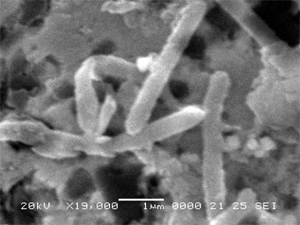Alkaliphilus metalliredigens can reduce Fe(III)-citrate, Fe(III)-EDTA, Co(III)-EDTA, or Cr(VI) as electron acceptors with yeast extract or lactate as electron donors (Ye et al., 2004). Growth during iron reduction occurs over the pH range of 7.5 to 11.0, a sodium chloride range of 0 to 80 g/l and a temperature range of 4°C to 45°C (Ye et al., 2004). Optimal growth conditions during iron reduction in the presence of borate (2 g/l) were observed at a pH of 9.6, a sodium chloride concentration of 20 g/l and a temperature of approximately 35°C. A. metalliredigens is a strict anaerobe that can tolerate up to 1.5% (w/v) borax (Na2B4O7), and the cells are straight rods that produce endospores. The microorganism appears to be a novel metal-reducing bacterium that is distantly related to other commonly studied iron-reducing microorganisms. At the present time, the most closely related microorganisms are Alkaliphilus transvaalensis and Alkaliphilus crotonatoxidans. A. transvaalensis was isolated from deep gold mines in South Africa, and could grow in the pH range of 8.5 to 12.5 (Takai et al., 2001). A. crotonatoxidans was isolated from an anaerobic digester for the treatment of bean curd waste water, and has a pH range of 5.5 to 9.0 (Cao et al., 2003). Motivation for Genome Sequence Determination. |
||
|
||
Alkaliphilus metalliredigens QYMF

